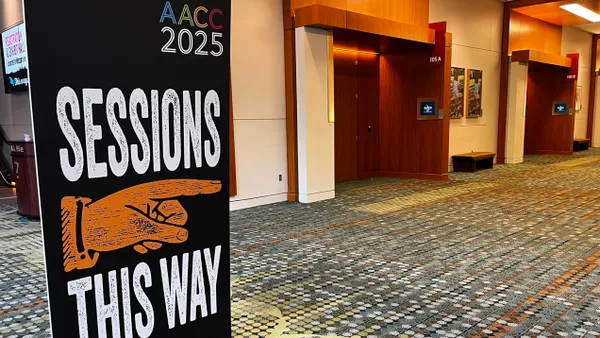Dive Brief:
- The number of foreign students earning degrees in science, technology, engineering or mathematics has risen steadily for decades, according to new data from the Congressional Research Service (CRS).
- About 22% of all STEM degrees in the U.S. were conferred to foreign students in the 2016-17 academic year, up from 11% in 1988-89. Master's degrees account for the majority of the credentials awarded.
- That share could shrink, however, as colleges report declines in enrollment of foreign students, who are generally considered to be a boon to the sector and the economy at-large.
Dive Insight:
International students are attractive to U.S. colleges because they are almost never eligible for financial aid and therefore pay full tuition, the CRS report notes.
Despite accounting for a little more than 5% of enrollment in colleges and universities in the country, foreign students deliver as much as $39 billion to the U.S. economy, NAFSA: Association of International Educators, reported earlier this year.
But administrators have indicated concern that stricter visa policies, anti-immigrant rhetoric and, to an extent, more expensive tuition will deter foreign students. Some students have in recent months reported delays in receiving visas as a result of the tighter vetting under the Trump administration.
Those factors could already be having an effect. The number of foreign students newly enrolling in U.S. colleges was down 6.6% from 2016-17 to 2017-18, and by 9.6% from 2015-16, according to data from the Institute of International Education.
More than 1 million foreign students are enrolled at American colleges, and of those students, about half are studying in STEM fields, which the CRS report considered to be mathematics, computer science, physical and life sciences and engineering. There is no federal definition for STEM.
About 54% of master's degrees and 44% of doctoral degrees in STEM were issued to foreign students in 2016-17, the report states.
The Optional Practical Training program, which lets foreign students stay in the U.S. to work after graduation, has been a draw for STEM students, particularly after the federal government extended the timeframe to three years. From 2008 to 2016, the number of STEM graduates in the OPT program climbed 400%, compared to a 49% increase in non-STEM grads, according to the Pew Research Center.
The majority of foreign STEM students at U.S. colleges in 2017-18 came from China (162,000 students) and India (154,000). This is a significant increase from the 2009-10 academic year — the earliest period for which the federal government had access to reliable data — when 72,000 students from India and 56,000 students from China were pursuing STEM degrees in the U.S.
Chinese students account for around one-third of all international enrollment in U.S. colleges. But tensions between that country and the U.S. have some in higher ed concerned about maintaining them as a source of tuition revenue.
In June, The Washington Post reported that officials in China had warned students publicly about the "risks" of studying in America. Those officials claimed that the educational relationship between the countries had been "politicized."
Sarah Spreitzer, director of government and public affairs at the American Council on Education, told Education Dive at the time that U.S. institutions should "continue to message that they want to remain welcoming and that international and global partnerships remain very important for (them)."
Other ways U.S. colleges are trying to attract foreign students include lowering tuition for them, working with recruitment firms and STEM-certifying their programs.














